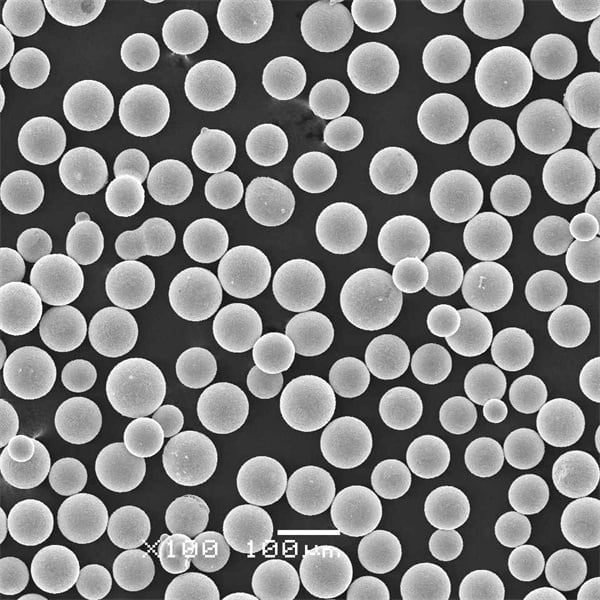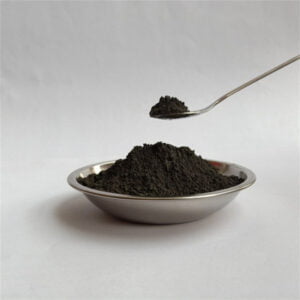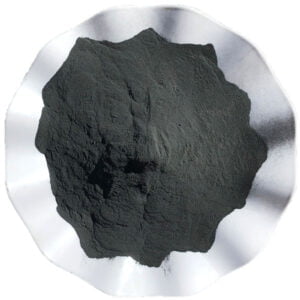SLS metallpulver: Egenskaper, användningsområden och leverantörer
Innehållsförteckning
Selective laser sintering (SLS) is an additive manufacturing technique that uses a laser to fuse small particles of plastic, metal, ceramic or glass powders into a 3D object. SLS metal powders with the right characteristics are critical to fabricating high-quality metal parts with complex geometries via this process.
Overview of SLS Metal Powders
SLS metal powders refer to metallic powders that are optimized for use in selective laser sintering 3D printers to produce metal parts and prototypes. The most commonly used SLS metal powders include:
SLS Metal Powder Types
| Typ | Sammansättning | Viktiga egenskaper |
|---|---|---|
| Rostfritt stål | Fe, Cr, Ni alloys | Korrosionsbeständighet, hög hållfasthet |
| Verktygsstål | Fe, Cr, Mo alloys | High hardness, heat treatable |
| Alloy steel | Fe, Cr, Ni alloys | Värmebehandlingsbar, bearbetbar |
| Cobalt-chrome | Co, Cr alloys | Biocompatible, wear/corrosion resistant |
| Titanium & alloys | Ti, Al, V alloys | Lightweight, biocompatible, strong |
| Inconel | Ni, Cr alloys | Heat/corrosion resistant |
| Aluminiumlegeringar | Al, Cu, Mg alloys | Lätt och stark |
These metal powders must have properties like flowability, particle shape and size distribution tailored to produce high density SLS parts with accuracy, precision and desired mechanical properties.
Key Properties of SLS Metal Powders
| Parameter | Beskrivning | Krav och önskemål |
|---|---|---|
| Storleksintervall | Powder particle dimensions | 10-45 mikrometer vanligt |
| Storleksfördelning | Range of powder sizes | Mostly spherical with some satellites allowed |
| Morfologi | Powder particle shape | Spherical is optimal, satellites can cause defects |
| Flödeshastighet | Flödbarhet för pulver | 35-40 s/50g from Hall flowmeter |
| Skenbar densitet | Packningsdensitet för pulver | Around 60% of true density |
| Sann densitet | Material density | Varies by composition |
| Yta | Particle surface area per unit mass | Lower is better to reduce oxidation |
| Residual gases & moisture | Impurities present with powder | Minimized for high quality parts |
SLS Metal Powder Characteristics
| Karaktäristisk | Role in SLS Process |
|---|---|
| Particle shape and surface texture | Affect powder flow into each new layer, laser absorption, reflectivity |
| Fördelning av partikelstorlek | Impacts packing density, melt pool dynamics, spreadability |
| Flödesegenskaper | Allows uniform spreadability, layer consistency |
| Skenbar densitet | Controls spacing between particles, energy input needed |
| Sann densitet | Determines final maximum attainable part density |
| Alloying additions | Enables specific material properties like strength, hardness etc. |

Tillämpningar av SLS Metal Powders
SLS metal powder enables printing of full density functional metal parts serving prototyping, tooling and short run production needs across industries like:
Industry Applications of SLS Printed Metal Parts
| Industri | Tillämpningar | Common Materials Used |
|---|---|---|
| Flyg- och rymdindustrin | Turbine blades, engine/structural components | Stainless steels, superalloys, titanium alloys |
| Fordon | Prototype parts, custom tooling | Stainless steels, tool steels, aluminum alloys |
| Medicinska implantat | Patient-specific implants, guides | Cobalt chrome, titanium alloys, stainless steel |
| Industriell | Precision tooling, robot grippers | Rostfria stål, verktygsstål |
| Smycken | Rings, chains, custom pieces | Precious metals like gold alloys, silver |
Some unique benefits versus traditional manufacturing routes:
Advantages of SLS for Metal Part Production
| Förmån | Beskrivning |
|---|---|
| Geometry freedom | No part geometry restrictions unlike subtractive/casting methods |
| Quick turnaround | Rapid printing from CAD data |
| Light weighting | Lattice structures reduce weight by >30% |
| Konsolidering av delar | Integrally printed assemblies replace joints |
| Massanpassning | Patient-specific medical devices |
| Hybrid structures | Metal & polymer multi-material parts possible |
Common SLS printed metal part applications across industries:
Typical Applications of SLS Printed Metal Parts
| Tillämpning | Exempel | Använda material |
|---|---|---|
| Funktionella prototyper | Engine components, implants | Alloy steels, Ti alloys |
| Verktyg | Drill guides, fixtures, jigs | Rostfria stål |
| Mold tooling | Injection molding tooling | Verktygsstål som H13 |
| Serieproduktion | Aerospace/medical components | Ti & Ni alloys, CoCr |
| Lättviktsstrukturer | Lattice panels, braces | Al alloys, Ti alloys |
SLS Metal Powder Specifications
SLS system manufacturers like EOS, 3D Systems, and Renishaw provide qualified SLS metal powder specifications tailored for their printer models. Some common metal powders and sizes include:
SLS Metal Powder Types and Size Ranges
| Material | Tillgängliga pulvertyper | Partikelstorleksintervall |
|---|---|---|
| Rostfritt stål | 316L, 17-4PH, 303, 410 | 15-45 mikrometer |
| Maråldrat stål | MS1, 18Ni300, 18Ni350 | 15-45 mikrometer |
| Kobolt krom | CoCr, CoCrMo | 15-45 mikrometer |
| Aluminiumlegering | AlSi10Mg, AlSi12 | 15-45 mikrometer |
| Titanlegering | Ti6Al4V klass 5 | 15-45 mikrometer |
| Nickellegering | Inconel 718, Inconel 625 | 15-45 mikrometer |
Standards organizations have defined classifications for different metal powder grades used in AM processes:
Metal Powder Grades per ISO/ASTM Standards
| Standard | Betyg | Beskrivning |
|---|---|---|
| ISO 17296-2 | PA1 to PA6 | Defines increasingly stricter requirements on impurities from P1 to P6 |
| ISO 17296-3 | PM1 to PM4 | Defines particle shape, size parameters from PM1 to PM4 |
| ASTM F3049 | Class 1 to Class 4 | Defines allowable limits on composition ranges from 1 to 4 |
| ASTM F3056 | Type 1 to Type 3 | Defines statistical size distribution parameters from 1 to 3 |
These grading schemes help set benchmark quality levels and aid buyers in procurement. High purity PA5 grade powder would ensure minimal contamination. Similarly Class 4 tighter chemistry control reduces variability.
SLS Metal Powder Leverantörer
A variety of vendors supply ready-to-use SLS powders worldwide. Some leading global suppliers are:
Key SLS Metal Powder Suppliers
| Leverantör | Erbjudna material | Geografier som serveras |
|---|---|---|
| Sandvik | Stainless steel, Ni alloys, CoCr, tool steel, aluminum alloys | Europa, Asien |
| Praxair | Ti alloys, Ni alloys, stainless, tool steels | Nordamerika |
| LPW-teknik | Stainless steel, aluminum alloys, CoCr | UK, Europe |
| Snickare Tillsats | Stainless steels, CoCr, Cu, aluminum alloys | Globalt |
| Hoganas | Rostfria stål, verktygsstål | Europa, Asien |
Usual supply minimums are around 10 kg per material grade, though large volume contracts also exist for OEM buyers. Packaging options range from vacuum sealed cans to specialized SLS machine cartridges holding 700 g to 1 kg powder each.
SLS Metal Powder Packaging Types
| Typ | Volume Ranges | Egenskaper |
|---|---|---|
| Vacuum cans | 500g to 20kg batches | Shelf life up to 1 year |
| Printer cartridges | 700 to 1000g batches | Minimized handling exposure |
| Material towers | 700 to 1200g cartridges | Automated feed into printer |
Price ranges for common materials in small quantities are:
Metal Powder Cost Ranges for SLS Printing
| Material | Small Quantity Price Range* |
|---|---|
| Rostfritt stål 316L | $60-$100 per kg |
| Aluminium AlSi10Mg | $80-$130 per kg |
| Maråldrat stål | $90-$140 per kg |
| Titan Ti6Al4V | $200-$350 per kg |
| Kobolt krom | $300-$500 per kg |
| Ädelmetaller | $3000+ per kg |
Comparing SLS Metal Powder Materials
Various metal alloys are used for SLS printing, each with their own properties and tradeoffs:
SLS Metal Powder Materials Comparison
| Parameter | Rostfria stål | Verktygsstål | Titanlegeringar | Nickellegeringar | Kobolt Krom | Aluminiumlegeringar |
|---|---|---|---|---|---|---|
| Täthet | Medium | Högre | Lägre | Hög | Hög | Lägst |
| Styrka | Medium | Högsta | Medelhög-Hög | Medelhög-Hög | Medium | Medium |
| Hårdhet | Lägre | Mycket hög | Medium | Medium | Högre | Låg-Medium |
| Motståndskraft mot korrosion | Utmärkt | Medium | Utmärkt | Utmärkt | Utmärkt | Medium-Good |
| Biokompatibilitet | Bra | Begränsad | Utmärkt | Begränsad | Utmärkt | Bra |
| Värmebeständighet | Medium | Medelhög-Hög | Medium | Mycket hög | Mycket hög | Lägre |
| Kostnad | Lägst | Medium | Hög | Mycket hög | Hög | Låg |
We can see stainless steels offer the best combinational properties when cost is a consideration, while tool steels provide extreme hardness. Titanium brings biocompatibility and strength with low density. Superalloys like Inconel and CoCr offer thermal stability and biocompatibility. Aluminum alloys are the most cost-effective lightweight option.
Pros and Cons of Common SLS Metal Powders
| Material | Fördelar | Nackdelar |
|---|---|---|
| Rostfria stål | Cost-effective, readily machinable | Lower hardness and strength |
| Verktygsstål | Extremely hard and heat treatable | Less corrosion resistance, biocompatibility |
| Titanlegeringar | Strong, lightweight, bio-friendly | Expensive, can burn in oxygen atmosphere |
| Nickellegeringar | Excellent heat/corrosion resistance | Heavy, toxic, very expensive |
| Kobolt krom | Biokompatibel, korrosionsbeständig | Heavy, medium cost |
| Aluminiumlegeringar | Lätt vikt, god hållfasthet | Lower melting point, hardness |
Customer Criteria for Selecting SLS Metal Powder
| Urvalskriterier | Viktiga frågor |
|---|---|
| Mekaniska egenskaper | Does it meet target application strength, wear resistance and other mechanical specifications? |
| Materialkostnad | Does desired metal powder type fit application budgets? |
| Efterbearbetning | Are secondary operations like Hot Isostatic Pressing or heat treatment needed? |
| Production run size | Is target volume too high for production SLS printing? |
| Part size dimensions | Is maximum printer build volume sufficient for largest part geometries? |
| Resolution, surface finish | Can SLS process achieve fine-feature-detail and surface quality requirements? |
| Delivery lead time | Is supplier lead time acceptable considering production timeline? |
The end part application guides optimal material selection balancing performance needs and economics.
SLS Metal Printing Process Overview
Understanding SLS 3D printing helps appreciate how powder properties affect part quality:
SLS 3D Printing Process Stages
| Etapp | Beskrivning |
|---|---|
| 3D Modeling | CAD software creates solid/mesh model of part to print |
| Skivning | Model is digitally sliced into layers to generate printer file |
| Powder spreading | Roller or blade spreads thin layer of powder on build platform |
| Laser scanning | CO2 laser scans over powder bed to melt particles together |
| Lowering platform | Build platform lowers by 1 layer thickness (~50 microns) |
| Repeat spreading/melting | Steps repeat until full object is built up layer-by-layer |
| Efterbearbetning | Excess powder removed, final treatments done to finish part |
How Powder Characteristics Impact Print Results
| Pulverfastighet | Influence on Print Quality |
|---|---|
| Geometri för pulver | Spherical particles with good flow enable uniform layers without defects |
| Partikelstorleksintervall | Too fine powders have poor flow, too large creates poor resolution |
| Storleksfördelning | Too wide a distribution can segregate or create variable melting |
| Skenbar densitet | Higher density yields greater final part density after sintering |
| Sann densitet | Places upper limit on achievable part density |
| Surface texture | Rougher particles can trap gases or hamper powder flow |
We can see several powder physical properties directly impact print results, so tight control by suppliers is crucial.
Post-Processing of SLS Printed Metal Parts
After the SLS printing process, additional finishing steps help improve final part properties:
Common SLS Part Post-Processing Steps
| Process | Beskrivning | Fördelar |
|---|---|---|
| Avlägsnande av pulver | Excess powder brushed/blasted off | Reveals printed object |
| Stresslindrande | Heating to remove residual stresses | Improves dimensional accuracy |
| Ytbehandling | Sanding, polishing, bead blasting | Smoothens surface, aids coating adhesion |
| Infiltration | Liquid fills residual porosity | Further increases density, improves strength |
| Värmebehandling | Hardening and tempering thermal cycles | Enhances hardness in steels |
Post-Processing Effects on Part Properties
| Fastighet | Post-Processing Influence |
|---|---|
| Täthet | Infiltration with epoxy or bronze fills pores increasing density 5-15% |
| Ytjämnhet | Manual/automated polishing can achieve under 2 micron roughness |
| Dimensionell noggrannhet | Stress relieving heat cycle reduces warpage improving precision |
| Draghållfasthet | Infiltration improves UTS while heat treatment can double yields strength |
| Duktilitet | Tradeoff with strength improvement from post-treatments |
| Hårdhet | Precipitation hardenable alloys like 17-4PH respond well to aging treatments |
Thus post-processing allows tailoring metal properties further based on application needs.
SLS Metal Printing Quality Control
Consistent high quality powder feedstock coupled with SLS process monitoring ensures reliable parts:
Quality Control for SLS Metal Powder
| Parameter | Typisk specifikation | Testmetoder |
|---|---|---|
| Fördelning av partikelstorlek | Hall flow rate > 35s/50g | Siktning, laserdiffraktion |
| Skenbar densitet | 65-80% of true density | Gravimetric measurement |
| Pulversammansättning | Alloying ranges per ISO 27296 | X-Ray fluorescence |
| Ytmorfologi | Median circularity > 0.75 | Micrographs, image analysis |
| Kontaminering | < 50 ppm oxygen, < 150 ppm nitrogen | Fusionsanalys med inert gas |
In-Process Monitoring for SLS Printing
| Metrisk | Sensor Used | Syfte |
|---|---|---|
| Laserkraft | Built-in photodiode | Maintains fusion consistency |
| Temperatur i pulverbädd | IR sensor | Ensures part integrity, no warping |
| Atmosfär | Oxygen analyzer | Avoids powder ignition in build chamber |
| Skiktets tjocklek | Z-axis encoder | Precise reproducible layers |
Such stringent control over input powder and process settings results in high quality metal parts from each production run.
SLS Metal Printing Compared to Alternatives
Other metal 3D printing alternatives to SLS include:
Comparison of Metal 3D Printing Methods
| Metrisk | Binder Jetting | DMLS | SLM | EBM |
|---|---|---|---|---|
| Råmaterial | Metal/polymer mix powder | Metallpulver | Metallpulver | Metal wire/powder |
| Energikälla | Flytande bindemedel | Fiberlaser | Powerful Yb fiber laser | Elektronstråle |
| Bygg fart | Moderate, faster than laser methods | Slow due to point-by-point scanning | Very fast, full melting occurs | Fastest method |
| Resolution, surface finish | Poorer due to binder, post-processing helps | Very good due to fine laser spot | Excellent due to full melting | Moderate due to partial melting |
| Dimensionell noggrannhet | +/- 0.3% with CTQ process | +/- 0.1-0.2% | +/- 0.1-0.2% | +/- 0.2-0.3% |
| Efterbearbetning | Curing, sintering both needed | Only support removal | Some machining may be needed | Most secondary work needed |
| Kostnad per del | Lower material cost helps reduce price | Much higher operating cost | High equipment, material cost | Hög kostnad för utrustning |
Among all methods, binder jetting has emerged as most cost-effective for metal part production at lower volumes up to 10,000 units. SLS provides the easiest post-processing combined with good accuracy and surface finish.

Vanliga frågor
What industries use SLS metal printing?
SLS metal printing is used in aerospace, automotive, medical, and many other industries where precision metal parts are required.
What is the accuracy and resolution of SLS metal printing?
The accuracy and resolution depend on several factors, including the machine, material, and process parameters, but SLS metal printing can achieve high levels of precision.
Is post-processing required for SLS metal-printed parts?
Yes, post-processing may be required to remove support structures, improve surface finish, and meet specific requirements for the application.
What are the limitations of SLS metal printing?
Some limitations include the cost of equipment, limited size of build chambers, and the need for proper safety measures due to the use of lasers and metal powders.
Can SLS metal printing be used for mass production?
Yes, SLS metal printing can be used for both prototyping and low to medium-volume production of metal parts.
Is SLS metal printing environmentally friendly?
While it can reduce material waste compared to traditional manufacturing methods, the disposal of metal powders and energy consumption are factors to consider regarding its environmental impact.
Are there any safety precautions when working with SLS metal printing?
Yes, safety measures should be taken when handling metal powders, and operators should be trained to work with laser-based systems safely.
What is the cost of SLS metal printing services?
The cost varies depending on factors such as material choice, part complexity, and quantity. It’s best to request quotes from service providers for specific projects.
Dela på
MET3DP Technology Co, LTD är en ledande leverantör av lösningar för additiv tillverkning med huvudkontor i Qingdao, Kina. Vårt företag är specialiserat på 3D-utskriftsutrustning och högpresterande metallpulver för industriella tillämpningar.
Förfrågan för att få bästa pris och anpassad lösning för ditt företag!
Relaterade artiklar

Högpresterande segment för munstycksvingar: Revolutionerande turbineffektivitet med 3D-utskrift i metall
Läs mer "Om Met3DP
Senaste uppdateringen
Vår produkt
KONTAKTA OSS
Har du några frågor? Skicka oss meddelande nu! Vi kommer att betjäna din begäran med ett helt team efter att ha fått ditt meddelande.

Metallpulver för 3D-printing och additiv tillverkning
FÖRETAG
PRODUKT
cONTACT INFO
- Qingdao City, Shandong, Kina
- [email protected]
- [email protected]
- +86 19116340731
















